Frilled Sharks got their name from the six rows of gills on their throat that look like ruffled collars.
Advertisement
Frilled Shark Scientific Classification
- Kingdom
- Animalia
- Phylum
- Chordata
- Class
- Chondrichthyes
- Order
- Hexanchiformes
- Family
- Chlamydoselachidae
- Genus
- Chlamydoselachus
- Scientific Name
- Chlamydoselachus anguineus
Read our Complete Guide to Classification of Animals.
Frilled Shark Conservation Status
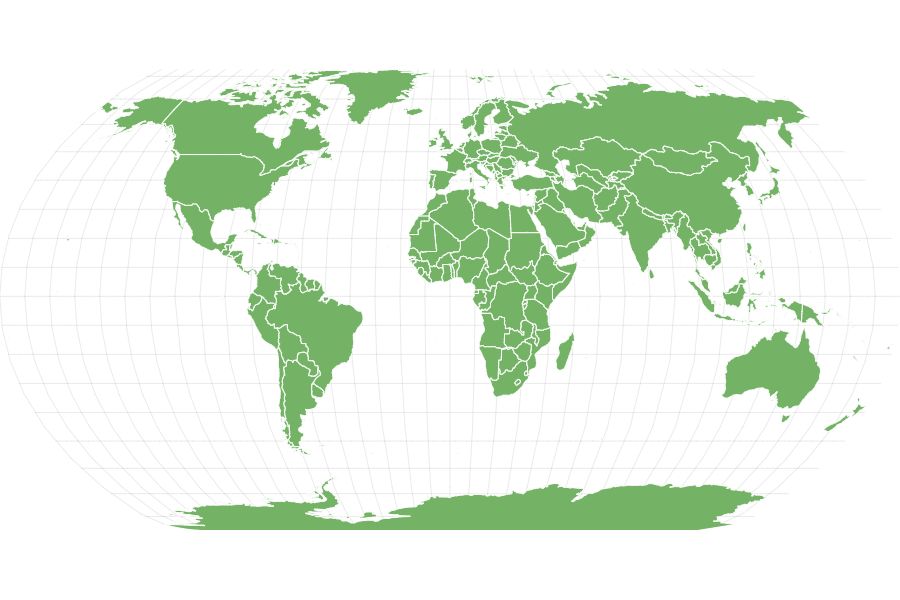
Frilled Shark Facts
- Prey
- Squid, smaller sharks, bony fish
- Group Behavior
- Solitary
- Fun Fact
- Frilled Sharks got their name from the six rows of gills on their throat that look like ruffled collars.
- Estimated Population Size
- Unknown
- Most Distinctive Feature
- Long and slender eel-like bod
- Other Name(s)
- Frill-Gilled Shark, Scaffold Shark, Silk Shark, Greenland Shark, Fringe Shark, Lizard Shark
- Gestation Period
- Possibly as long as 42 months
- Habitat
- Deep sea
- Predators
- Other shark species
- Diet
- Omnivore
- Favorite Food
- Squid, smaller sharks, bony fish
- Common Name
- Frilled Shark
- Number Of Species
- 2
- Location
- Deep sea
View all of the Frilled Shark images!
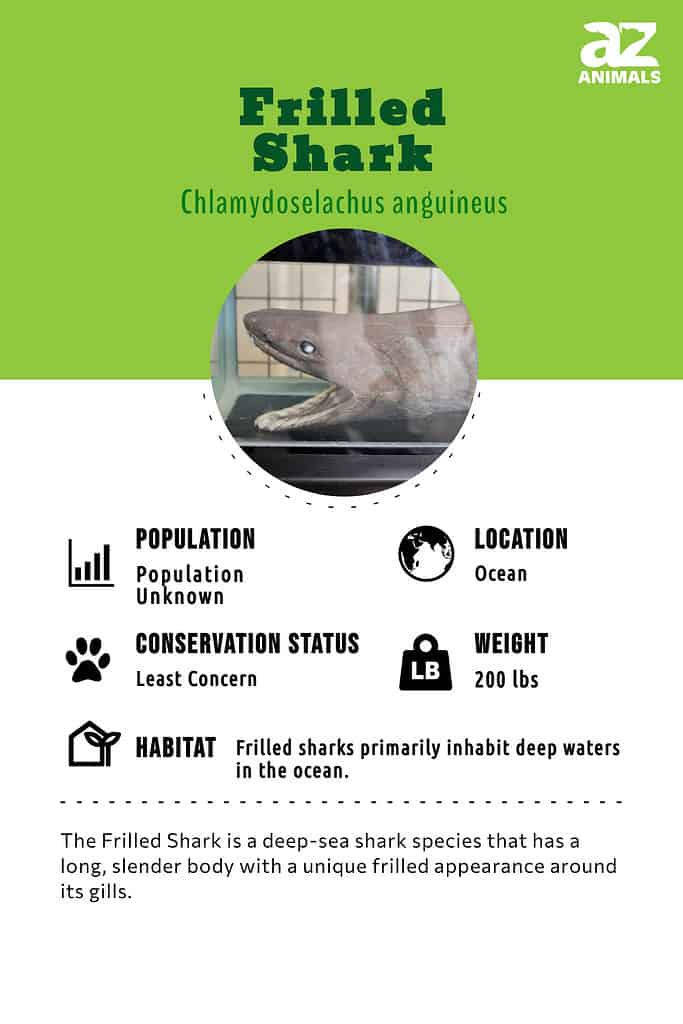
Frilled Sharks are a primitive-looking species that resemble an eel.
They are considered living fossils because of their primitive traits, like their brown color, long body, and placement of their jaws.
Frilled Sharks spend most of their time deep beneath the surface of the water. They are most commonly found at depths between 390 and 4,200 feet below the surface.
Frilled Sharks were given their name because of the six pairs of gills along their throat that look like ruffled collars.
5 Incredible Frilled Shark Facts!
- The gestation period of a Frilled Shark may be up to 42 months.
- The Southern African Frilled Shark species was just classified as a separate species in 2009.
- Female Frilled Sharks are larger than males.
- Frilled Sharks have more than 25 rows of teeth.
- The first video of a Frilled Shark wasn’t recorded until 2004.
Classification and Scientific Name
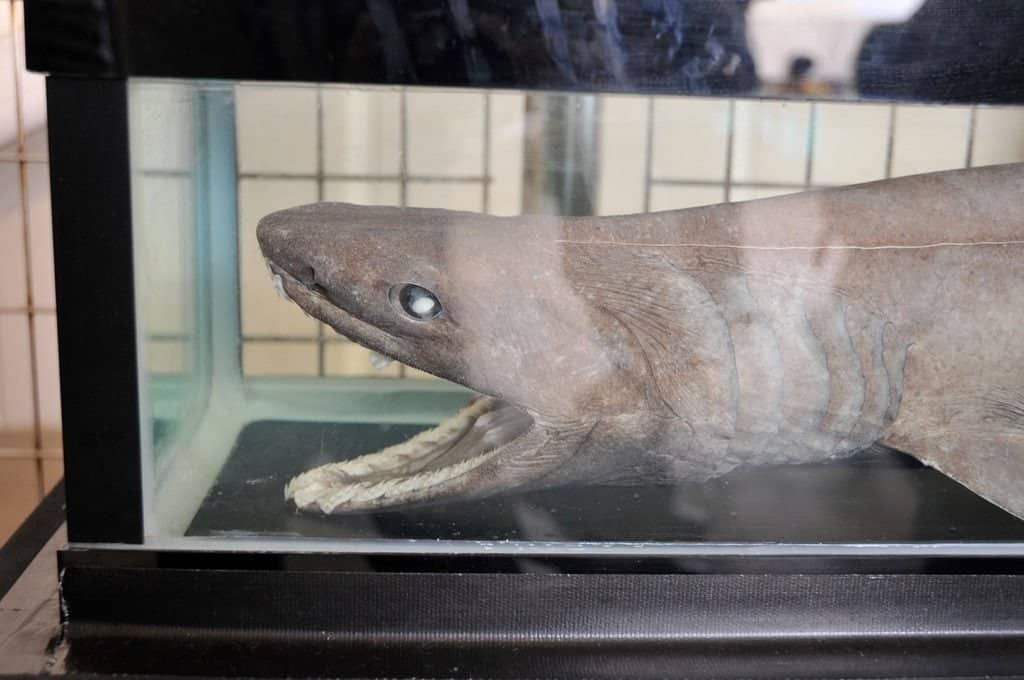
The scientific name assigned to the Frilled Shark is Chlamydoselachus anguineus.
©saname777 from Tokyo, Japan / CC BY 2.0 – License
The Frilled Shark’s scientific name is Chlamydoselachus anguineus. Chlamydoselachus is Greek. Chlamy means frill in Greek, videos mean cape, and selachus means shark.
Anguineus is a Latin word that means eel-like or snake-like. These sharks are part of the Chondrichthyes class and the Chlamydoselachidae family.
There are two Frilled Shark species. In addition to the Chlamydoselachus anguineus, there is also the Chlamydoselachus africana or the Southern African Frilled Shark. These two species of Frilled Sharks are the only species in the Chlamydoselachidae family.
Frilled Sharks are also called Frill-Gilled Sharks, Scaffold Sharks, Silk Sharks, Greenland Sharks, Frill Sharks, Fringe Sharks, and Lizard Sharks.
Appearance
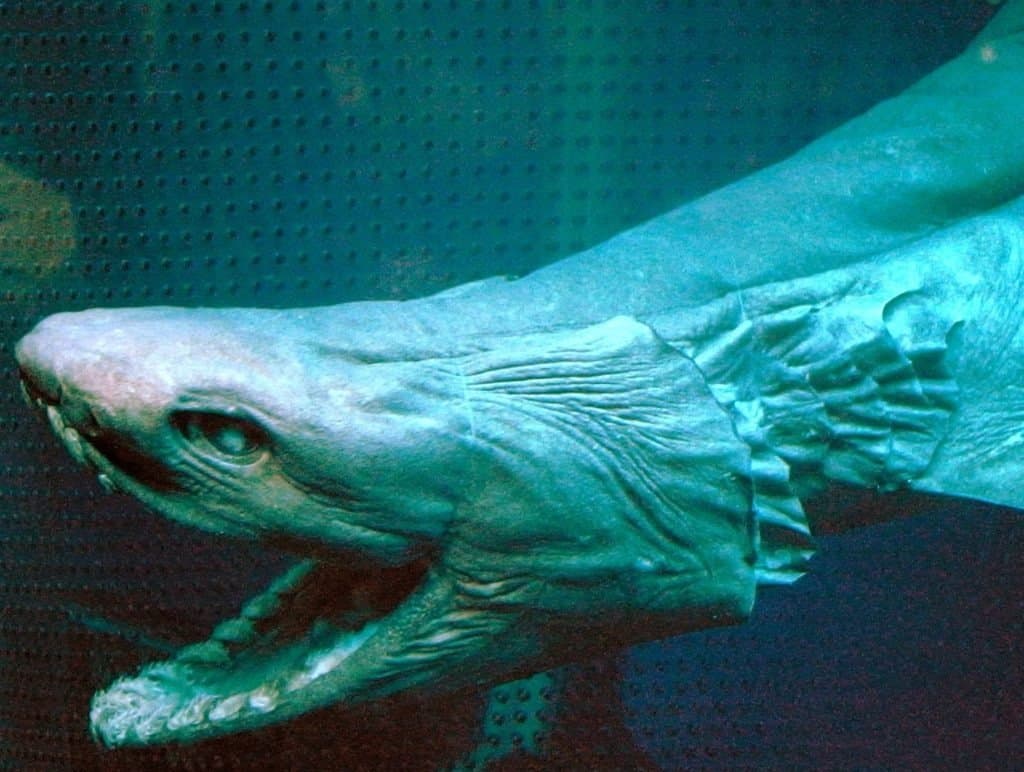
These sharks have a body shape that resembles that of an eel or a snake.
©OpenCage / CC BY-SA 2.5 – License
The body of these sharks actually looks quite similar to an eel or snake. They have a very primitive appearance with a long and slender body.
They have a flat head with a rounded snout. The fins on these sharks are much smaller than those you’d see on other species of sharks. They also have a ruffled throat and six pairs of gills, that look similar to collars. These collar-looking gills are the reason the Frilled Shark was given his name.
Most other shark species have jaws that are underneath their heads. However, a Frilled Shark’s jaws are actually at the end of its head. They have over 25 rows of teeth with approximately 300 teeth total.
These sharks’ bodies can be up to 6.4 feet long. Females are longer than males in this species. The average length of a female is between 4.4 and 4.9 feet, and the average length of a male is between 3.2 and 3.6 feet.
These sharks are pretty dark in color. They can be a darker brown color to more gray.
There are a few key differences between this shark and the Southern African Frilled Shark. The Southern African Sharks have a shorter heads, larger pectoral finds, and fewer vertebrae in their spinal column.
Evolution and Origins
The frilled shark is a relatively new species in the history of the Earth, with the earliest fossilized teeth of the Chlamydoselachus anguineus shark dating back to the early Pleistocene epoch (2.58-11.70 million years ago).
Frilled sharks are frequently found in Suruga Bay, Japan, particularly in depths ranging from 50 m to 200 m, while in the western Indian Ocean, they are identified as C. africana and located off South Africa.
In the western Pacific, these sharks can be discovered off the coasts of Japan and as far south as New Zealand, New South Wales, and Tasmania in Australia.
According to Ebert, the frilled shark was first found in Japan in 1884, and he himself discovered the southern African frilled shark in 2009, which is the only other known species of frilled shark. These sharks are considered living fossils because their physical features have remained largely unchanged over time.
Distribution, Population, and Habitat
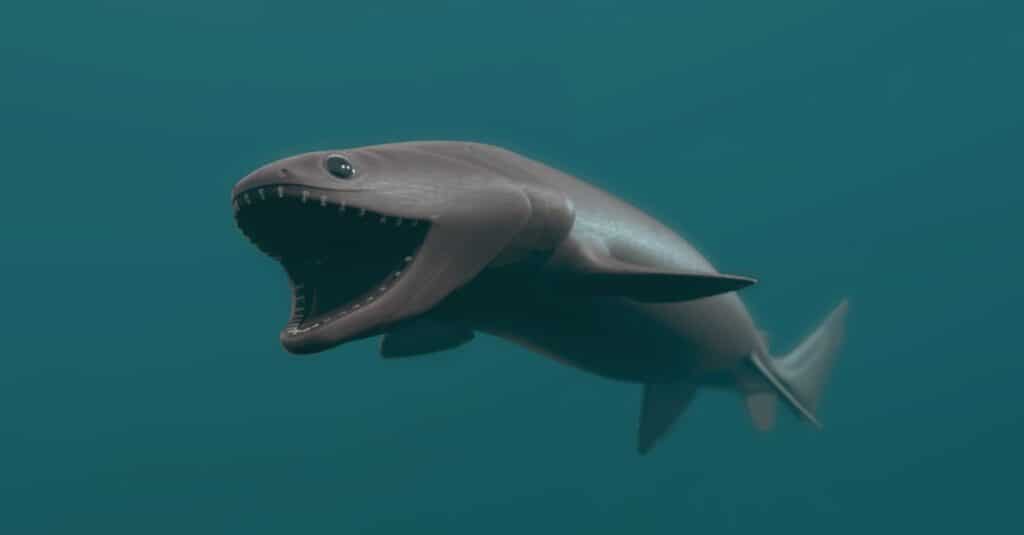
These sharks mainly inhabit the ocean’s deeper regions.
©iStock.com/3dsam79
These sharks primarily live in the deeper waters of the ocean. They can be found along the outer continental shelf and upper-to-middle continental shelf. While they will go to the surface of the water at night to hunt for food, most of the rest of their time is spent along the floor of the ocean. They are usually found between 390 and 4,200 feet beneath the surface but may go as deep as 5,150 feet beneath the surface.
These sharks can be found in many different areas around the globe. A few places they can be found include Suruga Bay in Japan, off the coasts of New Zealand, Australia, and Hawaii. They are also found in the Pacific Ocean between California and Chile and in the Atlantic Ocean between Norway and Namibia. The Southern African Frilled Shark is found in the Indian Ocean near South Africa.
These sharks engage in spatial separation within their habitats. Spatial separation is when the members of a species create their own microhabitat where they spend their time. This is because they are unable to inhabit the same area as another shark for any real length of time.
Since these sharks live in the deep waters of the ocean, scientists still have a lot to learn about the species. There currently is no estimate related to the total population of them or whether their numbers are increasing or decreasing.
This shark currently has a conservation status of Least Concern, but since so little is known about the species it is unclear how threatened they are. These sharks can be caught in fishing nets, which may have a greater impact on the population of the species since they have such a long gestation period.
Predators and Prey
What Eats Frilled Sharks?
There is still much to learn about these sharks. One thing that we still need to study more is which animals prey on them. It is believed that other shark species are predators of this shark, but not much is known beyond this.
While humans don’t generally try to catch these sharks, they have been caught by fishing nets before. This often causes the shark to die, which may have a negative impact on its population since they have such a long gestation period.
Overfishing by humans also leads to a decrease in the available food for these sharks. This can pose an additional threat to the species.
What Do Frilled Sharks Eat?
These sharks hunt for their food. They curve their long, eel-like body up and brace themselves against something solid. Then, when they see prey, they will use this position to quickly advance their body forward and bite their prey, much like a snake.
They are able to eat prey that is up to half of their size thanks to their very long jaws. These sharks may also swim around with their mouths open as they look for prey. The contrast of their white teeth against the darkness of the ocean may entice the prey to swim toward their open mouth.
As much as 60 percent of the shark’s diet is made up of different types of squids, including the Onychoteuthis, Histioteuthis, and Todarodes. These sharks also eat smaller species of sharks and bony fish.
Reproduction and Lifespan
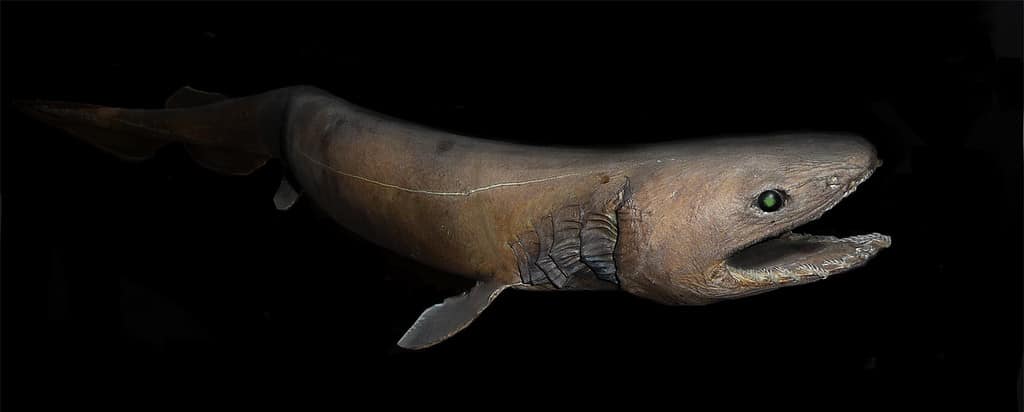
Frilled shark,
Chlamydoselachus anguineus.©Citron / CC-BY-SA-3.0 – License
Males are sexually mature when they are between 3.3 and 3.9 feet long, and females are sexually mature when they are between 4.3 and 4.9 feet long. There is not a set breeding season for these sharks since their habitat is deep enough that the changing seasons have no impact on it.
Unlike many other animals, they do not connect with their young through a placenta. Rather, they produce via internal fertilization and the embryos survive by gaining nutrition from yolk sacs. These sharks give birth to live young but only do so once the young sharks are already equipped to survive on their own. Because of this, they may have the longest gestation period of any animal at around 42 months.
Females can give birth to somewhere between two and 15 young at a time. The average litter size is six, however. When born, young sharks are between 15 and 24 inches long.
Scientists are unsure exactly how long Frilled Sharks can live, but they have estimated that their lifespan is about 25 years.
Fishing and Cooking
While these sharks have occasionally been caught in fishing nets, people do not purposefully fish for these animals. They are not used in cooking.
View all 91 animals that start with FFrilled Shark FAQs (Frequently Asked Questions)
Where does the Frilled Shark live?
Frilled Sharks are spread out in different areas around the world. They live off of the coasts of Japan, Hawaii, New Zealand, and Australia. Frilled Sharks can also be found between Norway and Namibia in the Atlantic Ocean and between California and Chile in the Pacific Ocean. Southern African Frilled Sharks are found near South Africa in the Indian Ocean.
What does the Frilled Shark eat?
Frilled sharks eat squid, smaller sharks, and bony fish.
What does a Frilled Shark look like?
Frilled Sharks have a very primitive appearance and almost look more like a snake or an eel than a shark. Their body is very long and their head is flat with a rounded snout. Their throat is ruffled with six pairs of gills, which resemble collars.
Are Frilled Sharks dangerous to humans?
No, Frilled Sharks do not pose a risk to humans. They swim deep below the surface of the water, not near where humans may be.
How many Frilled Sharks are left?
Scientists currently do not have a population estimate for Frilled Sharks. They live deep beneath the surface of the water, and it is challenging to know just how many Frilled Sharks are left.
What Kingdom do Frilled Sharks belong to?
Frilled Sharks belong to the Kingdom Animalia.
How do Frilled Sharks have babies?
Frilled Sharks give birth to live young.
Thank you for reading! Have some feedback for us? Contact the AZ Animals editorial team.
Sources
- Wikipedia, Available here: https://en.wikipedia.org/wiki/Frilled_shark
- Marine Bio, Available here: https://marinebio.org/species/frilled-sharks/chlamydoselachus-anguineus/
- Elasmo Research, Available here: http://www.elasmo-research.org/education/ecology/deepsea-frilled_shark.htm
- Mentalfloss, Available here: https://www.mentalfloss.com/article/60129/11-fascinating-facts-about-frilled-shark
- Marine Conservation Society, Available here: https://www.mcsuk.org/30species/frilled-shark#:~:text=There's%20no%20global%20population%20estimate,and%20species%20may%20well%20exist.
- Everywhere Wild, Available here: https://everywherewild.com/frilled-shark/#:~:text=The%20scientific%20name%20of%20the%20frilled%20shark%20is%20Chlamydoselachus%20anguineus.&text=The%20second%20part%2C%20anguineus%2C%20is,or%20%E2%80%9Ceel%2Dlike.%E2%80%9Dim
- Oceana, Available here: https://oceana.org/marine-life/sharks-rays/frilled-shark
















